|
|
|
Friday, October 24th 2008 [ versión español ]
My tree sprout, my youth has passed,
today beneath its shadow
that has grown so much,
we share memories, my tree and I.
Alberto Cortez
|
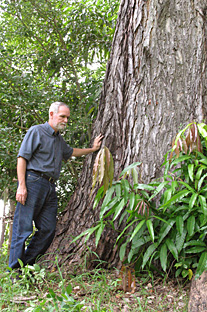 |
|
Doctor José A. Mari Mutt beside a massive Mahogany, located in the square at UPRM. Photograph by Mariam Ludim Rosa |
|
|
Majestic silhouettes that with their leaves reach the sky. From my window, I am able to observe them every day. At this time of the year, they receive the caressing touches of raindrops in the afternoon. I’m sure it brings them joy.
There is one directly in front of my window and although I look at it daily, today I decided to take special notice of it. I didn’t know its name; today I discovered that it is a 60-year-old Mahogany, which was planted a little after the end of the construction of the Monzón Building, where my office is located.
An enormous sense of curiosity drove me to try and find out the names of all the different types of trees that surround my office. I called Doctor José A. Mari Mutt whose e-book, Árboles del Recinto Universitario de Mayagüez (Trees of the University of Puerto Rico at Mayagüez (UPRM)) became available this week, and I asked him: “What type of tree is the one that resides outside my office window?” He courteously responded that he would pass by so that he could answer my question.
That is how I learned that vast greenness that paints my sky has names such as Rain Tree, Oak, Mammy and Australian pine, which are among other rather immense trees that reach great heights. These are just a few of the approximately three thousand trees that exist on the almost one hundred year old campus.
Mari Mutt, a biologist, shared with me that the motivation for writing his book came from a presentation he gave on his previous book, Maderas de Puerto Rico (Puerto Rican Woods). At this presentation, a colleague commented to Mari Mutt that, for him, every tree was the same.
“At that moment it occurred to me that our campus didn’t have a guide, something written that would allow visitors, students, and professors to recognize and identify the trees,” said Mari Mutt.
I remembered that on various occasions I had seen the professor around campus with a camera in his hands. He was taking pictures of the trees, and now these pictures, approximately 700 of them, are available in his e-book, which offers a description of each species.
“Now the campus has a tool that will allow the Biology Department to develop new strategies for their courses. They could divide the campus into sections and ask that the students to identify the trees in their sections as part of a project.”
In his book, which can be found at http://arbolesrum.info, I discovered that only four percent of the trees on campus are endemic- a local species that doesn’t exist anywhere else-such as the beautiful Violet Tree. The majority of them are exotic species that were brought by professors from different trips around the world.
“Which is your favorite tree?” I asked the professor. Without thinking twice he told me it was the Cojóbana tree. There is only one on campus and it is located in front of the Piñero Building. “This tree’s leaves, to me, are the most beautiful because they resemble feathers, they have so many budding leaves, thousands,” commented Mari Mutt.
An interesting fact about trees is that, using their seeds the Taínos made a hallucinogenic powder that was used as a means to communicate with the spirits. Just as the Cojóbana tree, each tree has a particular way in which it shows its life history.
“Trees have distinct stories, some of which are very interesting. Some trees have spent their existence with people walking right by.” That is the case of a Tamarind Tree located near the stairs, which has been named “cuesta del Calvario.” This tree was planted in 1910 as a commemorative element of Arbor Day. “Can you imagine the generations of students that have passed by that tree?”, asked Mari Mutt.
Yes, more than imagining them, I have seen them from my window. A young man laying down in the grass reading a book below the shade of the Oak Tree, those who congregate to pray near the Pink Lapacho, and those who surf the web beneath an enormous Mahogany.
They are massive beings that provide us with coolness, shade and even support. They are living witnesses of 97 years of history at UPRM.
My tree remains and time has passed
Today beneath its shadow, that has grown so much
We share our memories, my tree and I.
Vídeo
Verify that your navegator can ejecutate javascript and that has the most recent version of Adobe Flash Player. Dowmload Flash Player
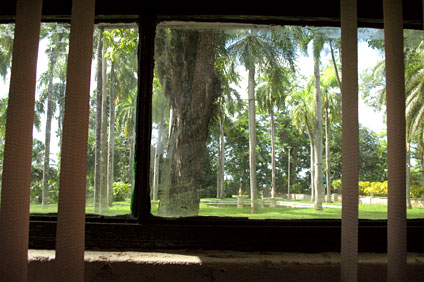
View from my office window in the Monzón building. Photograph by Mariam Ludim Rosa
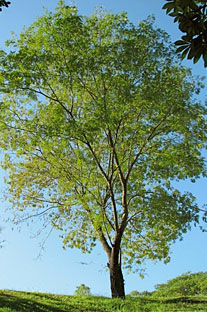 |
|
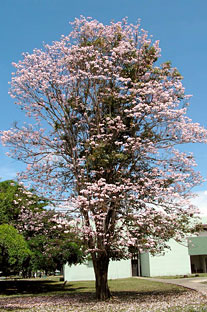 |
| There is only one Cojóbana tree at on campus and it is located at the front of the Piñero building. |
|
White oak tree located to the east of the Nursing building |
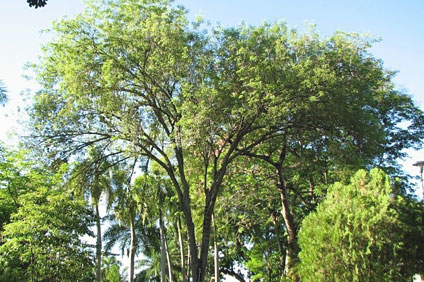
This Pink Lapacho is located near the Chancellor’s home.
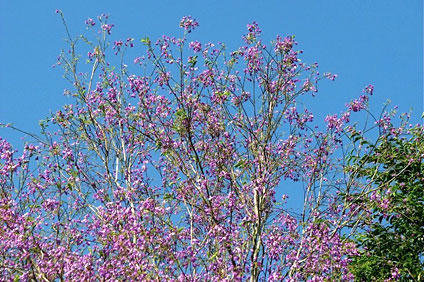 Violet tree flowers. Violet tree flowers.
Photographs borrowed from the e-book “Árboles de Puerto Rico”.
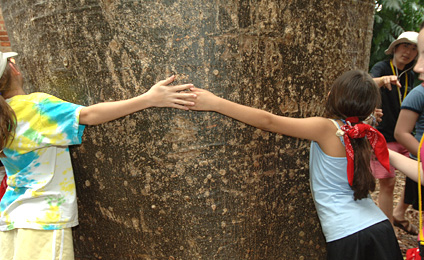 Children hugging a Canoa tree. Archive photo Children hugging a Canoa tree. Archive photo
|

